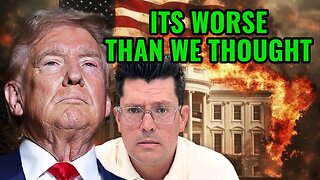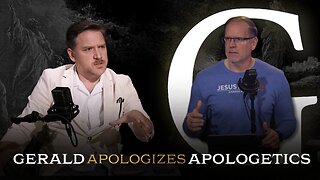Premium Only Content

Episode 3285: Anathema vs. Indefectibility: Can the Church Contradict Herself?
November 7, 2025
www.catholic-reboot.com
Nightly Zoom Coordinates for Rosary:
Meeting ID: 865 8978 0399
Passcode: Wjjv4960!
Speak Lord for your Servant is Listening
Book Recommendation of the Day
Summa Theologica — St. Thomas Aquinas (I, Q.1–Q.12; II–II, Q.11 on Heresy)
Aquinas explores the metaphysical foundation of God’s unchangeable truth and the Church’s participation in it.
In II–II, Q.11 (“Of Heresy”), he explains:
“Those who, after having been baptized, obstinately maintain opinions contrary to the Church’s teaching… are rightly cut off by anathema.”
And yet, in I, Q.12–Q.25, he upholds the indefectibility of divine truth in the Mystical Body.
His reasoning forms the theological bedrock for later councils that invoked anathema to defend indefectibility.
Anathema vs. Indefectibility: Can the Church Contradict Herself?
Welcome, dear listeners, to another episode rooted in truth and tradition where we stand with the saints and martyrs of old to defend the faith of our fathers.
Today, we confront a question that pierces to the very heart of the Church’s crisis:
How can the Church, promised by Christ to be indefectible, appear to contradict herself through decrees, policies, or practices that run contrary to her own solemn teachings even to the point of anathematizing what was once sacred?
And more specifically:
If Cardinal Cupich’s suppression of the Traditional Latin Mass directly opposes the Council of Trent’s dogmatic decrees, could such actions fall under the very anathema Trent pronounced?
And if so, how does that square with the doctrine of indefectibility the promise that the Church can never fail?
This is not an episode for the faint of heart. It is one for Catholics who love the truth more than comfort, the Cross more than consensus, and fidelity more than approval.
Segment 1: The Meaning of “Anathema”
The word Anathema comes from the Greek anáthema, meaning “set apart” but in Church use, it signifies formal exclusion for obstinately rejecting revealed truth.
From the earliest councils, the Church invoked anathema not as a weapon of hate, but as a shield to protect the deposit of faith.
When the Council of Nicaea condemned Arianism, when Ephesus rejected Nestorius, and when Trent rebuked Protestant innovations, the phrase “Anathema sit” “let him be anathema” was not optional. It was a boundary drawn by Heaven.
At Trent, Session VII, Canon 13, the Church infallibly proclaimed:
“If anyone says that the received and approved rites of the Catholic Church… may be despised or omitted by the ministers without sin, or may be changed into other new rites… let him be anathema.”
Those words bind for eternity. They were spoken with the full authority of Christ’s Magisterium.
To suppress or ban the ancient liturgy as if it were harmful or outdated is to stand directly against this decree.
Hence, the faithful rightly ask: how can bishops or cardinals now forbid what the Church once declared untouchable?
It is not a matter of taste it is a matter of truth.
Segment 2: The Doctrine of Indefectibility
The Doctrine of Indefectibility is the divine assurance that the Church, founded by Christ, will never fall away from the truth nor cease to exist.
Christ Himself promised: “Thou art Peter, and upon this rock I will build My Church, and the gates of hell shall not prevail against it.” (Matthew 16:18)
This does not mean that every pope, bishop, or priest is free from error or sin.
History is full of weak shepherds and faithless prelates from the Arian heresy to the Great Western Schism.
What indefectibility guarantees is that the Church as the Mystical Body of Christ can never officially teach heresy as binding doctrine.
Infallibility and indefectibility are thus two pillars of divine protection: one guards truth, the other guarantees endurance.
But just as Christ’s own Passion involved betrayal and humiliation, the Church’s indefectibility does not exclude suffering, confusion, or apparent defeat.
She is, as St. Augustine said, “the moon shining by the reflected light of Christ” sometimes obscured by clouds, but never extinguished.
Segment 3: The Modern Crisis: When Hierarchy Conflicts with Doctrine
And here lies the heart of our crisis.
When bishops like Cardinal Blase Cupich prohibit the Traditional Latin Mass calling it divisive or outdated they are, in effect, contradicting Trent’s dogmatic decree and Pope St. Pius V’s papal bull Quo Primum of 1570, which declared:
“We order and enjoin that nothing must be added to Our recently published Missal, nothing omitted from it, nor anything whatsoever altered within it… This present Constitution shall be valid henceforth, now, and forever.”
Forever.
Not fifty years. Not “until Vatican II.” Forever.
So when modern prelates claim the authority to abolish or restrict that which a sainted pope commanded forever, the faithful face a moral and theological dilemma:
Do we obey man, or do we obey the unbroken Magisterium of the Church?
St. Robert Bellarmine gives the answer:
“Just as it is lawful to resist the Pope if he attacks the body, so it is lawful to resist him if he attacks souls or seeks to destroy the Church.”
This is not rebellion it is fidelity to Christ and His immutable truth.
The hierarchy can err. The Church cannot.
Individual shepherds may lose the faith; the Mystical Body of Christ never will.
Segment 4: Vatican II and the Age of Contradiction
The Second Vatican Council though pastoral and non-dogmatic introduced ambiguities that have produced confusion unprecedented in Church history.
On religious liberty, ecumenism, and liturgy, the language of the documents appears to diverge from past councils that ended with anathemas.
For example:
• Council of Florence (1439): “None of those existing outside the Catholic Church… can be made partakers of eternal life.”
• Trent (1547): “If anyone says that the sinner is justified by faith alone… let him be anathema.”
• Vatican II (Dignitatis Humanae): “The human person has a right to religious freedom.”
The faithful ask how can both be true?
The answer lies in the hermeneutic of continuity, long abandoned by modernists. When the Church teaches consistently through centuries, that is the living Magisterium. When new teachings appear to contradict that deposit, the faithful must cling to what was always taught “everywhere, always, and by all,” in the words of St. Vincent of Lérins.
Thus, when modern documents or hierarchs appear to contradict prior definitions sealed with “anathema sit,” the contradiction does not reside in the Church it resides in the men who misapply her authority.
Segment 5: Are They Anathematized?
So, could the current hierarchy be anathematized in practice?
If we read Trent literally, yes anyone who rejects or forbids the “received and approved rites” would incur the condemnation of Canon 13.
However, only a future orthodox pope or ecumenical council in continuity with Tradition could formally declare such an anathema.
But the faithful are not powerless in the meantime. They possess the sensus fidei the supernatural instinct of the faithful that recognizes when something is contrary to the Faith.
When Catholics see sacred Tradition persecuted, they are not schismatics for resisting they are guardians of the faith.
As Archbishop Lefebvre declared before his suspension:
“We are not the ones breaking unity; we are holding fast to what the Church has always done.”
To resist innovation that destroys faith is not defiance; it is obedience to the unchanging Christ.
The Church’s indefectibility means that even if the hierarchy falters, the Faith remains alive in the remnant who refuse to accept error. The light of Tradition burns, even if hidden under a bushel.
Segment 6: The Church in Eclipse
What we are living through may well be what Our Lady foretold at La Salette a time when “Rome will lose the faith and become the seat of the Antichrist.”
And yet she also promised: “The Church will be eclipsed, but not extinguished.”
The eclipse hides the sun, but the sun itself remains. So too the Church obscured, persecuted, misunderstood but never destroyed.
St. John Eudes once said,
“The most evident mark of God’s anger is when He permits His people to fall into the hands of unfaithful pastors.”
But even then, God raises up saints, faithful priests, and laity who will not bow before false altars.
We are witnessing both chastisement and purification. The errors of our age will not stand forever. The Immaculate Heart will triumph.
Closing Reflection
Dear friends, the promise of indefectibility does not spare us from crisis it assures us that truth will outlast every falsehood.
The Church cannot die because Christ cannot be defeated.
But as members of His Mystical Body, we must choose whether to stand with Tradition or drift with the tide of compromise.
Get punched in the face discussion
We end with a prayer for the Church, for her priests, and for all who seek the light of truth amid this present darkness.
Prayer
O Lord Jesus Christ, eternal High Priest and Good Shepherd, look with mercy upon Thy Church, now wounded and confused.
Preserve the faithful who cling to Thy unchanging truth.
Strengthen the bishops and priests who stand firm in the Faith of the Apostles.
Grant conversion to those who have strayed, and courage to those who suffer for the Holy Mass of Ages.
Through the intercession of the Blessed Virgin Mary, Mediatrix of all graces,
keep us steadfast until the Triumph of her Immaculate Heart and the renewal of Thy Holy Church.
In the name of the Father, and of the Son, and of the Holy Ghost. Amen.
-
 LIVE
LIVE
Redacted News
29 minutes ago"What I saw in Ukraine SHOOK me to my core" Ukraine is not a democracy, it never was | Redacted
5,981 watching -
 LIVE
LIVE
Russell Brand
1 hour agoHas he done it? Ukraine Accepts Core Peace Terms — Nobel Prize incoming? - SF655
4,649 watching -
 24:37
24:37
Stephen Gardner
1 hour agoTrump JUST Exposed 2 HUGE LIES meant to TAKE HIM DOWN!!
7156 -

vivafrei
1 hour agoCBS News "Debunks" The Blaze Pipe Bomber Story? Thomas Massie Threatened by Kash Patel? AND MORE!
4.1K4 -

The White House
5 hours agoVice President JD Vance Celebrates Thanksgiving with Servicemembers and Delivers Remarks
1.33K6 -
 59:49
59:49
The Quartering
2 hours agoMTG MELTDOWN On X, Hasan Piker Runs From Ben Shapiro & AI Nightmare!
73K30 -
 1:16:24
1:16:24
DeVory Darkins
3 hours agoDISTURBING: Eric Swalwell left DUMBFOUNDED after he gets confronted about trans athletes
58.7K36 -
 LIVE
LIVE
Dr Disrespect
5 hours ago🔴LIVE - DR DISRESPECT - ARC RAIDERS - RANDOM SQUADS
2,093 watching -
 2:06:36
2:06:36
Side Scrollers Podcast
4 hours agoThis is the Dumbest Story We’ve Ever Covered… | Side Scrollers
21.9K6 -
 1:13:26
1:13:26
Steven Crowder
6 hours ago🔴 Jay Dyer on Hollywood, The Occult, and the Attack on the American Soul
230K169